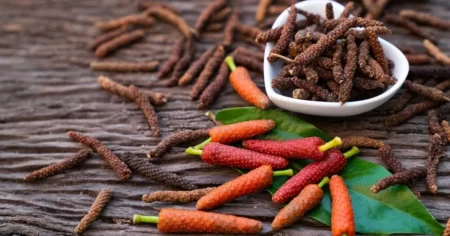Long Pepp er, scientifically known as Piper longum, is a spice that has been captivating taste buds and intriguing minds for centuries. Often overshadowed by its more popular counterpart, black pepper, long pepper boasts a unique flavor profile and a rich history that makes it a hidden gem in the world of spices. In this blog post, we’ll explore the origins, uses, and potential health benefits of long pepper.
er, scientifically known as Piper longum, is a spice that has been captivating taste buds and intriguing minds for centuries. Often overshadowed by its more popular counterpart, black pepper, long pepper boasts a unique flavor profile and a rich history that makes it a hidden gem in the world of spices. In this blog post, we’ll explore the origins, uses, and potential health benefits of long pepper.
Long pepper has deep roots in ancient Ayurvedic and traditional medicine. Originating from India, this spice has been used for its medicinal properties and culinary appeal for over 4,000 years. Its historical significance spans across various cultures, from ancient Greece to medieval Europe, where it was highly valued and sought after.
Flavor Profile and Culinary Uses: Unlike its close relative, black pepper, long pepper offers a more complex and subtle flavor. Described as having a slightly sweet, earthy, and spicy taste, long pepper can be used to add depth to both savory and sweet dishes. It pairs well with meats, stews, and even desserts, providing a distinctive kick to your culinary creations.
Health Benefits: Long pepper has been traditionally used in Ayurvedic medicine to address various health concerns. It is believed to have anti-inflammatory, digestive, and respiratory benefits. Recent studies also suggest that long pepper may have antioxidant properties, making it a potential ally in promoting overall health and well-being.
Frequently Asked Questions about Long Pepper
- What is Long Pepper, and how does it differ from regular black pepper?
Long Pepper, scientifically known as Piper longum, is a spice originating from India with a unique flavor profile distinct from black pepper. It has a slightly sweet, earthy, and spicy taste, offering a more complex experience compared to black pepper.
- How is Long Pepper traditionally used in cooking?
Long Pepper can be used in both savory and sweet dishes. It complements meats, stews, and desserts, adding depth and a distinctive kick to various culinary creations. Grinding long pepper or using it in spice blends are common methods of incorporating its flavor into dishes.
- What are the potential health benefits of Long Pepper?
Long Pepper has been traditionally used in Ayurvedic medicine for its anti-inflammatory, digestive, and respiratory benefits. Recent studies also suggest antioxidant properties, contributing to its potential in promoting overall health and well-being.
- Can Long Pepper be a substitute for black pepper in recipes?
While long pepper shares similarities with black pepper, its unique flavor makes it a distinct spice. It can be used as a substitute in some recipes, but the flavor difference should be considered.
- Where is Long Pepper grown, and what are its cultivation practices?
Long Pepper is primarily cultivated in India, but it can also be found in other tropical regions. Sustainable cultivation practices are essential to preserve this spice. Understanding the source and supporting responsible cultivation contributes to the long-term availability of quality long pepper.
- How do I store Long Pepper to maintain its freshness?
Long Pepper should be stored in a cool, dry place, away from direct sunlight. Using airtight containers helps maintain its flavor and aroma. Proper storage ensures that long pepper retains its quality for an extended period.
- Are there any side effects or precautions associated with consuming Long Pepper?
While long pepper is generally considered safe for consumption in culinary amounts, it’s essential to be mindful of individual sensitivities. As with any spice, moderation is key. If you have specific health concerns or conditions, it’s advisable to consult with a healthcare professional.
Follow For More; Facebook / Instagram / YouTube



